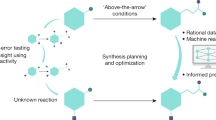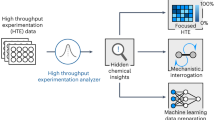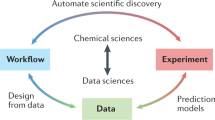Abstract
The varying quality of scientific reports is a well-recognized problem and often results from a lack of standardization and transparency in scientific publications. This situation ultimately leads to prominent complications such as reproducibility issues and the slow uptake of newly developed synthetic methods for pharmaceutical and agrochemical applications. In recent years, various impactful approaches have been advocated to bridge information gaps and to improve the quality of experimental protocols in synthetic organic publications. Here we provide a critical overview of these strategies and present the reader with a versatile set of tools to augment their standard procedures. We formulate eight principles to improve data management in scientific publications relating to data standardization, reproducibility and evaluation, and encourage scientists to go beyond current publication standards. We are aware that this is a substantial effort, but we are convinced that the resulting improved data situation will greatly benefit the progress of chemistry.

This is a preview of subscription content, access via your institution
Access options
Access Nature and 54 other Nature Portfolio journals
Get Nature+, our best-value online-access subscription
$29.99 / 30 days
cancel any time
Subscribe to this journal
Receive 12 print issues and online access
$259.00 per year
only $21.58 per issue
Buy this article
- Purchase on Springer Link
- Instant access to full article PDF
Prices may be subject to local taxes which are calculated during checkout



Similar content being viewed by others
References
van Gemmeren, M. & List, B. How and why crowd reviewing works. Synlett 32, 885–891 (2021).
Zhang, Y., Chen, S., Liu, Y. & Wang, Q. Route evaluation and Ritter reaction based synthesis of oxazoline acaricide candidates FET-II-L and NK-12. Org. Process Res. Dev. 24, 216–227 (2020).
Boda, K., Seidel, T. & Gasteiger, J. Structure and reaction based evaluation of synthetic accessibility. J. Comput. Aided Mol. Des. 21, 311–325 (2007).
Laird, T. Editorial reproducibility of results. Org. Process Res. Dev. 18, 921 (2014).
Wethman, R. et al. An under-appreciated source of reproducibility issues in cross-coupling: solid-state decomposition of primary sodium alkoxides in air. ACS Catal. 11, 502–508 (2021).
Kirklin, W. A. & Becker, W. W. Standardization in chemical industry. Anal. Chem. 23, 1556–1558 (1951).
Schnitzer, T. et al. How subtle changes can make a difference: reproducibility in complex supramolecular systems. Angew. Chem. Int. Ed. 134, e202206738 (2022).
Tiokhin, L. et al. Honest signaling in academic publishing. PLoS ONE 16, e0246675 (2021).
Cook, C. Publication fraud, dishonesty and deceit. J. Man. Manip. Ther. 20, 57–58 (2012).
Boström, J., Brown, D. G., Young, R. J. & Keserü, G. M. Expanding the medicinal chemistry synthetic toolbox. Nat. Rev. Drug Discov. 17, 709–727 (2018).
Schultz, D. & Campeau, L.-C. Harder, better, faster. Nat. Chem. 12, 661–664 (2020).
Bergman, R. G. & Danheiser, R. L. Reproducibility in chemical research. Angew. Chem. Int. Ed. 55, 12548–12549 (2016).
Scott, S. L., Gunnoe, T. B., Fornasiero, P. & Crudden, C. M. To err is human; to reproduce takes time. ACS Catal. 12, 3644–3650 (2022).
Baker, M. 1,500 scientists lift the lid on reproducibility. Nature 533, 452–454 (2016).
Kozlowski, M. C. On the topic of substrate scope. Org. Lett. 24, 7247–7249 (2022).
Kozlov, M. Revealed: the millions of dollars in time wasted making papers fit journal guidelines. Nature https://doi.org/10.1038/d41586-023-01846-9 (2023).
Wilkinson, M. D. et al. The FAIR Guiding Principles for scientific data management and stewardship. Sci. Data 3, 160018 (2016).
Kearnes, S. M. et al. The Open Reaction database. J. Am. Chem. Soc. 143, 18820–18826 (2021).
Tremouilhac, P. et al. The repository Chemotion: infrastructure for sustainable research in chemistry. Angew. Chem. Int. Ed. 59, 22771–22778 (2020).
Crystal‐Ornelas, R. et al. A guide to using GitHub for developing and versioning data standards and reporting formats. Earth Space Sci. 8, e2021EA001797 (2021).
Strieth-Kalthoff, F. et al. Machine learning for chemical reactivity: the importance of failed experiments. Angew. Chem. Int. Ed. 61, e202204647 (2022).
Schleinitz, J. et al. Machine learning yield prediction from NiCOlit, a small-size literature data set of Nickel catalyzed C-O couplings. J. Am. Chem. Soc. 144, 14722–14730 (2022).
Svejstrup, T. D. et al. Effects of light intensity and reaction temperature on photoreactions in commercial photoreactors. ChemPhotoChem 5, 808–814 (2021).
Wills, A. G., Poole, D. L., Alder, C. M. & Reid, M. A mechanistic and cautionary case study on the use of alternating potential in electrochemical reactions. ChemElectroChem 7, 2771–2776 (2020).
Kingston, C. et al. A survival guide for the ‘Electro-curious’. Acc. Chem. Res. 53, 72–83 (2020).
Leech, M. C. & Lam, K. A practical guide to electrosynthesis. Nat. Rev. Chem. 6, 275–286 (2022).
Beil, S. B., Pollok, D. & Waldvogel, S. R. Reproducibility in electroorganic synthesis—myths and misunderstandings. Angew. Chem. Int. Ed. 60, 14750–14759 (2021).
Hone, C. A. & Kappe, C. O. Towards the standardization of flow chemistry protocols for organic reactions. Chem. Methods 1, 454–467 (2021).
Steiner, S. et al. Organic synthesis in a modular robotic system driven by a chemical programming language. Science 363, eaav2211 (2019).
Collins, K. D. & Glorius, F. A robustness screen for the rapid assessment of chemical reactions. Nat. Chem. 5, 597–601 (2013).
Dreher, S. D. & Krska, S. W. Chemistry informer libraries: conception, early experience and role in the future of cheminformatics. Acc. Chem. Res. 54, 1586–1596 (2021).
Kutchukian, P. S. et al. Chemistry informer libraries: a chemoinformatics enabled approach to evaluate and advance synthetic methods. Chem. Sci. 7, 2604–2613 (2016).
Bess, E. N., Bischoff, A. J. & Sigman, M. S. Designer substrate library for quantitative, predictive modeling of reaction performance. Proc. Natl Acad. Sci. USA 111, 14698–14703 (2014).
Kariofillis, S. K. et al. Using data science to guide aryl bromide substrate scope analysis in a Ni/photoredox-catalyzed cross-coupling with acetals as alcohol-derived radical sources. J. Am. Chem. Soc. 144, 1045–1055 (2022).
Stevens, J. M. et al. Advancing base metal catalysis through data science: insight and predictive models for Ni-catalyzed borylation through supervised machine learning. Organometallics 41, 1847–1864 (2022).
Gensch, T. et al. Design and application of a screening set for monophosphine ligands in cross-coupling. ACS Catal. 12, 7773–7780 (2022).
Calvo-Flores, F. G. Sustainable chemistry metrics. Chem. Sus. Chem 2, 905–919 (2009).
Constable, D. J. C., Curzons, A. D. & Cunningham, V. L. Metrics to ‘green’ chemistry—which are the best? Green Chem. 4, 521–527 (2002).
Curzons, A. D., Mortimer, D. N., Constable, D. J. C. & Cunningham, V. L. So you think your process is green, how do you know?—Using principles of sustainability to determine what is green—a corporate perspective. Green Chem. 3, 1–6 (2001).
van Aken, K., Strekowski, L. & Patiny, L. EcoScale, a semi-quantitative tool to select an organic preparation based on economical and ecological parameters. Beilstein J. Org. Chem. 2, 3 (2006).
Anastas, P. T. & Lankey, R. L. Life cycle assessment and green chemistry: the yin and yang of industrial ecology. Green Chem. 2, 289–295 (2000).
Sheldon, R. A. Metrics of green chemistry and sustainability: past, present and future. ACS Sustain. Chem. Eng. 6, 32–48 (2018).
Anastas, P. T. & Warner, J. C. Green Chemistry. Theory and Practice 1st edn (Oxford Univ. Press, 1998).
Trost, B. M. The atom economy—a search for synthetic efficiency. Science 254, 1471–1477 (1991).
Trost, B. M. On inventing reactions for atom economy. Acc. Chem. Res. 35, 695–705 (2002).
Sheldon, R. A. The E Factor: fifteen years on. Green Chem. 9, 1273–1283 (2007).
Sheldon, R. A. Atom efficiency and catalysis in organic synthesis. Pure Appl. Chem. 72, 1233–1246 (2000).
Sheldon, R. A. Organic synthesis—past, present and future. Chem. Ind. 23, 903–906 (1992).
Jimenez-Gonzalez, C., Ponder, C. S., Broxterman, Q. B. & Manley, J. B. Using the right green yardstick: why process mass intensity is used in the pharmaceutical industry to drive more sustainable processes. Org. Process Res. Dev. 15, 912–917 (2011).
Poliakoff, M. & Licence, P. Sustainable technology: green chemistry. Nature 450, 810–812 (2007).
Gaich, T. & Baran, P. S. Aiming for the ideal synthesis. J. Org. Chem. 75, 4657–4673 (2010).
Heinzle, E. et al. Ecological and economic objective functions for screening in integrated development of fine chemical processes. Ind. Eng. Chem. Res. 37, 3395–3407 (1998).
Fussler, C. & James, P. Driving ECO-innovation. A Breakthrough Discipline for Innovation and Sustainability (Pitman, 1996).
Sajid, M. & Płotka-Wasylka, J. Green analytical chemistry metrics: a review. Talanta 238, 123046 (2022).
Pena-Pereira, F., Wojnowski, W. & Tobiszewski, M. AGREE-analytical GREEnness metric approach and software. Anal. Chem. 92, 10076–10082 (2020).
Lie, Y., Ortiz, P., Vendamme, R., Vanbroekhoven, K. & Farmer, T. J. BioLogicTool: a simple visual tool for assisting in the logical selection of pathways from biomass to products. Ind. Eng. Chem. Res. 58, 15945–15957 (2019).
Phan, T. V. T., Gallardo, C. & Mane, J. GREEN MOTION: a new and easy to use green chemistry metric from laboratories to industry. Green Chem. 17, 2846–2852 (2015).
Andraos, J. Unification of reaction metrics for green chemistry: applications to reaction analysis. Org. Process Res. Dev. 9, 149–163 (2005).
Lapkin, A. & Constable, D. (eds) Green Chemistry Metrics. Measuring and Monitoring Sustainable Processes (Wiley-Blackwell, 2009).
Goodhart, C. A. E. (ed.) Monetary Theory and Practice (Macmillan, 1984).
Collins, K. D., Gensch, T. & Glorius, F. Contemporary screening approaches to reaction discovery and development. Nat. Chem. 6, 859–871 (2014).
Mennen, S. M. et al. The evolution of high-throughput experimentation in pharmaceutical development and perspectives on the future. Org. Process Res. Dev. 23, 1213–1242 (2019).
Prieto Kullmer, C. N. et al. Accelerating reaction generality and mechanistic insight through additive mapping. Science 376, 532–539 (2022).
Gensch, T., Teders, M. & Glorius, F. Approach to comparing the functional group tolerance of reactions. J. Org. Chem. 82, 9154–9159 (2017).
Bayeh, L., Le, P. Q. & Tambar, U. K. Catalytic allylic oxidation of internal alkenes to a multifunctional chiral building block. Nature 547, 196–200 (2017).
Leger, P. R., Murphy, R. A., Pushkarskaya, E. & Sarpong, R. Synthetic efforts toward the Lycopodium alkaloids inspires a hydrogen iodide mediated method for the hydroamination and hydroetherification of olefins. Chemistry 21, 4377–4383 (2015).
Beutner, G. L. et al. Palladium-catalyzed amidation and amination of (hetero)aryl chlorides under homogeneous conditions enabled by a soluble DBU/NaTFA dual-base system. Org. Process Res. Dev. 23, 1529–1537 (2019).
Gensch, T. & Glorius, F. The straight dope on the scope of chemical reactions. Science 352, 294–295 (2016).
Collins, K. D. & Glorius, F. Intermolecular reaction screening as a tool for reaction evaluation. Acc. Chem. Res. 48, 619–627 (2015).
Friis, S. D., Johansson, M. J. & Ackermann, L. Cobalt-catalysed C–H methylation for late-stage drug diversification. Nat. Chem. 12, 511–519 (2020).
Richardson, J., Ruble, J. C., Love, E. A. & Berritt, S. A method for identifying and developing functional group tolerant catalytic reactions: application to the Buchwald–Hartwig amination. J. Org. Chem. 82, 3741–3750 (2017).
Simon, K. et al. Automated flow and real-time analytics approach for screening functional group tolerance in heterogeneous catalytic reactions. Catal. Sci. Technol. 12, 1799–1811 (2022).
Collins, K. D., Rühling, A., Lied, F. & Glorius, F. Rapid assessment of protecting-group stability by using a robustness screen. Chemistry 20, 3800–3805 (2014).
Anhäuser, L., Teders, M., Rentmeister, A. & Glorius, F. Bio-additive-based screening: toward evaluation of the biocompatibility of chemical reactions. Nat. Protoc. 14, 2599–2626 (2019).
Pitzer, L., Schäfers, F. & Glorius, F. Rapid assessment of the reaction-condition-based sensitivity of chemical transformations. Angew. Chem. Int. Ed. 58, 8572–8576 (2019).
Strehl, J. & Hilt, G. Electrochemical, iodine-mediated α-C-H amination of ketones by umpolung of silyl enol ethers. Org. Lett. 22, 5968–5972 (2020).
Strehl, J. & Hilt, G. Synthesis of symmetrical and unsymmetrical thiosulfonates from disulfides through electrochemically induced disulfide bond metathesis and site‐selective oxidation. Eur. J. Org. Chem. 2022, e202101007 (2022).
Guo, W., Wang, M., Han, Z., Huang, H. & Sun, J. Organocatalytic asymmetric synthesis of α-amino esters from sulfoxonium ylides. Chem. Sci. 12, 11191–11196 (2021).
Liu, Y. et al. Carbene-catalyzed enantioselective aromatic N-nucleophilic addition of heteroarenes to ketones. Angew. Chem. Int. Ed. 59, 442–448 (2020).
Uttry, A., Mal, S. & van Gemmeren, M. Late-stage β-C(sp3)-H deuteration of carboxylic acids. J. Am. Chem. Soc. 143, 10895–10901 (2021).
Xie, H., Jiang, J. & Wang, J. Rhodium(III)-catalyzed C-H/N-H functionalization with hydrogen evolution. Chemistry 26, 7365–7368 (2020).
Heusler, A., Fliege, J., Wagener, T. & Glorius, F. Substituted dihydropyridine synthesis by dearomatization of pyridines. Angew. Chem. Int. Ed. 60, 13793–13797 (2021).
Moock, D., Wagener, T., Hu, T., Gallagher, T. & Glorius, F. Enantio- and diastereoselective, complete hydrogenation of benzofurans by cascade catalysis. Angew. Chem. Int. Ed. 60, 13677–13681 (2021).
Liu, J., Morgan, S. & Hoover, J. M. Cobalt‐catalyzed aerobic oxidative cyclization of 2‐aminoanilines with isonitriles: facile access to 2‐aminobenzimidazoles. ChemCatChem 12, 1297–1301 (2020).
Wu, H., Dai, W., Saravanamurugan, S., Li, H. & Yang, S. Endogenous X–C=O species enable catalyst-free formylation prerequisite for CO2 reductive upgrading. Green Chem. 22, 5822–5832 (2020).
Su, X.-D. et al. Additive-free, visible-light-enabled decarboxylative alkylation of enamides. Org. Lett. 23, 8262–8266 (2021).
Lapkin, A. & Constable, D. J. C. Green Chemistry Metrics (Wiley, 2008).
Andraos, J. & Sayed, M. On the use of ‘green’ metrics in the undergraduate organic chemistry lecture and lab to assess the mass efficiency of organic reactions. J. Chem. Educ. 84, 1004 (2007).
Sandfort, F., Knecht, T., Pinkert, T., Daniliuc, C. G. & Glorius, F. Site-selective thiolation of (multi)halogenated heteroarenes. J. Am. Chem. Soc. 142, 6913–6919 (2020).
Acknowledgements
We thank T. Dalton (Bayer AG), F. Katzenburg (University of Münster) and L. Quach (Evonik) for helpful assistance and discussions. This work received generous financial support from the Deutsche Forschungsgemeinschaft (Leibniz Award, SFB 1459).
Author information
Authors and Affiliations
Contributions
All authors were part of the conceptualization, investigation and writing of this Perspective, and they all approved the final version of the manuscript.
Corresponding author
Ethics declarations
Competing interests
The authors declare no competing interests.
Peer review
Peer review information
Nature Chemistry thanks Jason Stevens, Samantha Kanza and the other, anonymous, reviewer(s) for their contribution to the peer review of this work.
Additional information
Publisher’s note Springer Nature remains neutral with regard to jurisdictional claims in published maps and institutional affiliations.
Rights and permissions
Springer Nature or its licensor (e.g. a society or other partner) holds exclusive rights to this article under a publishing agreement with the author(s) or other rightsholder(s); author self-archiving of the accepted manuscript version of this article is solely governed by the terms of such publishing agreement and applicable law.
About this article
Cite this article
Schrader, M.L., Schäfer, F.R., Schäfers, F. et al. Bridging the information gap in organic chemical reactions. Nat. Chem. 16, 491–498 (2024). https://doi.org/10.1038/s41557-024-01470-8
Received:
Accepted:
Published:
Issue Date:
DOI: https://doi.org/10.1038/s41557-024-01470-8



